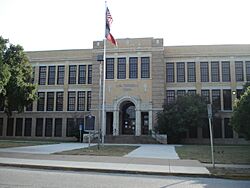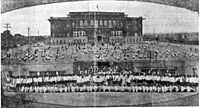I.M. Terrell High School facts for kids
Quick facts for kids I.M. Terrell High School |
|
|---|---|

Site of former I.M. Terrell High School as of 2013.
|
|
| Address | |
|
1411 I.M. Terrell Circle S.
, 76102
|
|
| Coordinates | 32°44′56.54″N 97°18′52.50″W / 32.7490389°N 97.3145833°W |
| Information | |
| Other name | I.M. Terrell Academy for STEM and VPA (2018) |
| School type | High school (Public) |
| Established | 1882 |
| Status | Reopened (2018) |
| Closed | 1973 (I.M. Terrell High School) |
| School district | Fort Worth Independent School District |
| Superintendent | Alexander Hogg (1882) I.M. Terrell (1890) |
| Principal | I.M. Terrell (1910-1915) |
| Faculty | 26 (1940s) |
| Grades | 9-11 (1940s) |
| Enrollment | 900 (1940s) |
| Athletics conference | Prairie View Interscholastic League |
| Communities served | Fort Worth; also Arlington, Bedford, Benbrook, Burleson, Roanoke, Weatherford |
 I.M. Terrell High School at its previous location in 1921. |
|
I.M. Terrell High School was a very important high school in Fort Worth, Texas. It opened in 1882 as the city's first public school for African American students. This was during a time when schools were formally separated by race in the United States.
The high school closed in 1973. However, the building reopened in 1998 as an elementary school. After a big renovation, it is now the I.M. Terrell Academy for STEM and VPA. STEM stands for Science, Technology, Engineering, and Math. VPA stands for Visual and Performing Arts. The school building is part of the Butler Place Historic District.
Contents
Discovering I.M. Terrell High School's History
Early Years and Founding
In 1882, Isaiah Milligan Terrell (1859–1931) became the leader of the East Ninth Street Colored School. This was the first free public school for African Americans in Fort Worth. Terrell became the Principal and Superintendent of Colored Schools in 1890.
In 1906, the school moved to a new spot. It was then called North Side Colored School No. 11. A brand new school building opened in 1910, with Terrell as its principal.
Renaming and Challenges
In 1915, Terrell left the school to work at Prairie View State Normal and Industrial College. This college is now Prairie View A&M University. In 1921, the school was renamed I.M. Terrell High School to honor its former principal.
In its early years, the school faced many challenges. It did not have a gym, a cafeteria, or a library. There were also not enough classrooms. Textbooks were old ones passed down from nearby white schools. Later, a teacher named Lillian B. Jones Horace helped start the school's first library. She asked parents and students to donate books.
New Location and Growth
In 1938, the school moved again. It went into an older building that used to be a white elementary school. This building was at 1411 East Eighteenth Street. The building was made bigger as part of a Works Progress Administration project. The school's old location then became an elementary and junior high school.
By the 1940s, I.M. Terrell High School had 26 teachers. It served 900 students in grades 9 through 11. The school was chosen to be part of a special study. This study helped African American teachers develop new teaching methods.
Serving Students from Other Towns
I.M. Terrell High School served students from Fort Worth. It also welcomed students from towns outside the city. These towns included Arlington, Bedford, Benbrook, Burleson, Roanoke, and Weatherford. This was because African American children in those areas could not attend school.
School Closure and Reopening
I.M. Terrell High School closed in 1973. This happened during the time when schools in Fort Worth were ending racial separation. The building reopened in 1998 as I.M. Terrell Elementary School.
In 2004, the street around the school was renamed I.M. Terrell Circle South. In 2018, the old elementary school reopened as the I.M. Terrell Academy for STEM and VPA. This happened after a big renovation project that cost $41 million.
The School's Amazing Music Program
G.A. Baxter was the music teacher at I.M. Terrell High School in the middle of the 1900s. Many students who later became famous jazz and rhythm and blues musicians went to the school then. Some say Mr. Baxter encouraged students to try new sounds. Others remember him as a strict band director who did not like jazz.
Free jazz pioneer Ornette Coleman was in the school band. He was removed from the band for making up his own music during a song called "The Washington Post." Other famous musicians who attended I.M. Terrell with Coleman include John Carter, King Curtis, Prince Lasha, Charles Moffett, and Dewey Redman. Julius Hemphill, Ronald Shannon Jackson, Cornell Dupree, Billy Tom Robinson, Thomas Reese, and Ray Sharpe also graduated from I.M. Terrell.
Ronald Shannon Jackson shared his memories in an interview in 1981:
Dallas was bigger than Fort Worth, but Fort Worth always had the cats who were on the money in terms of the music. It had a lot to do with our music teacher there, Mr. Baxter. He played all the instruments. He loved to perfect a band. He put his whole life into music — to the point it would drive him mad, so dedicated, totally dedicated. A lot of people come through this man: he was Ornette Coleman's teacher, he was Dewey Redman's teacher, he was Julius Hemphill's teacher, Charles Moffett's teacher and John Carter's and mine. King Curtis, my father's cousin, also came from there.
I.M. Terrell's Athletic Program
From 1951 to 1966, I.M. Terrell High School was part of the Prairie View Interscholastic League. This league joined with the University Interscholastic League in 1970.
Hall of Fame coach Robert Hughes coached the basketball team at Terrell. He coached from 1958 until the high school closed. Coach Hughes was the winningest high school basketball coach in the United States for many years. He is still the winningest boys' high school basketball coach in the country.
Notable Alumni
- John Carter, musician
- Ornette Coleman, musician
- King Curtis, musician
- Cornell Dupree, musician
- Lillian B. Horace, educator and author
- Julius Hemphill, musician
- Ronald Shannon Jackson, musician
- Prince Lasha, musician
- Opal Lee, activist, the "Grandmother of Juneteenth"
- George Minor, baseball outfielder
- Rosalind Miles, actress and fashion model
- Charles Moffett, musician
- Dewey Redman, musician
- Ray Sharpe, musician

